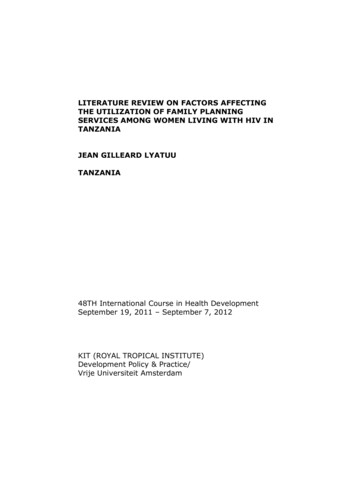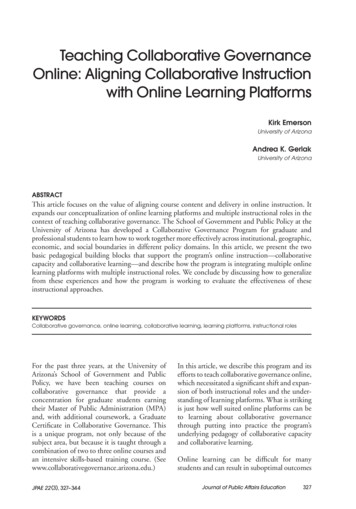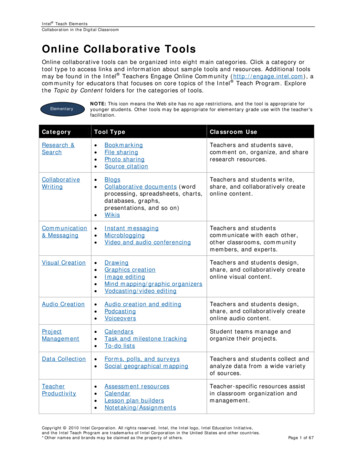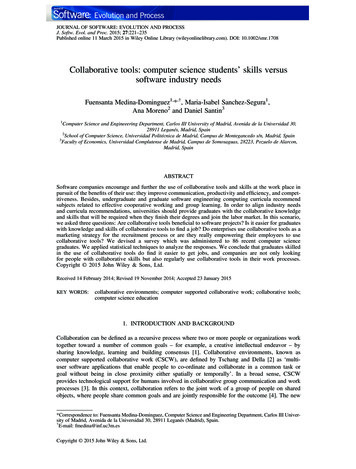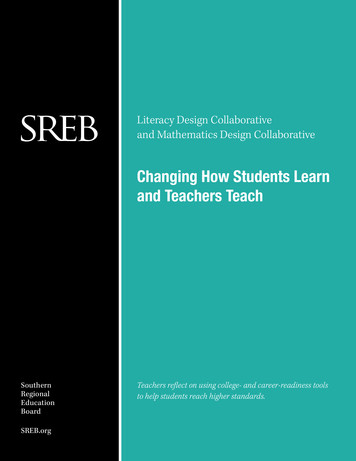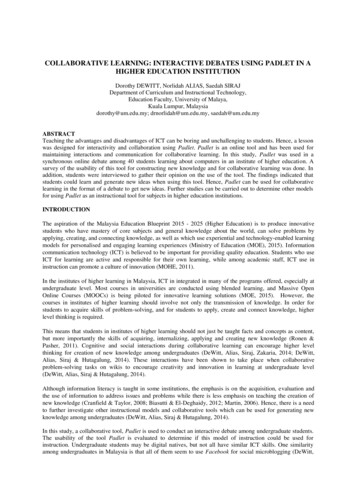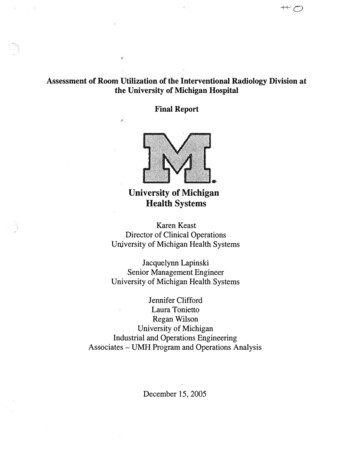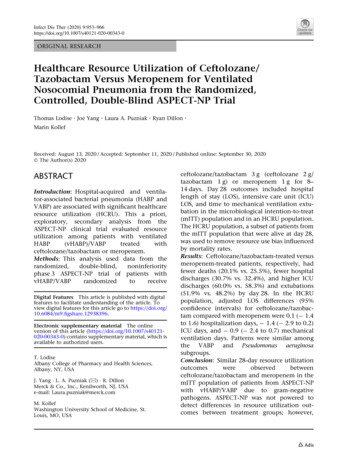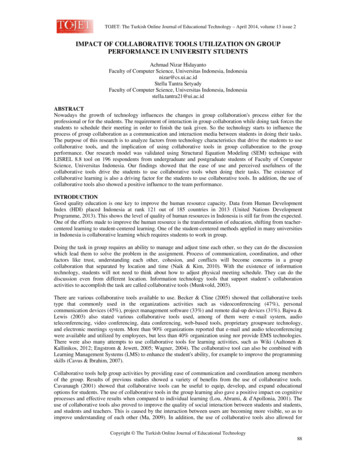
Transcription
TOJET: The Turkish Online Journal of Educational Technology – April 2014, volume 13 issue 2IMPACT OF COLLABORATIVE TOOLS UTILIZATION ON GROUPPERFORMANCE IN UNIVERSITY STUDENTSAchmad Nizar HidayantoFaculty of Computer Science, Universitas Indonesia, Indonesianizar@cs.ui.ac.idStella Tantra SetyadyFaculty of Computer Science, Universitas Indonesia, Indonesiastella.tantra21@ui.ac.idABSTRACTNowadays the growth of technology influences the changes in group collaboration's process either for theprofessional or for the students. The requirement of interaction in group collaboration while doing task forces thestudents to schedule their meeting in order to finish the task given. So the technology starts to influence theprocess of group collaboration as a communication and interaction media between students in doing their tasks.The purpose of this research is to analyze factors from technology characteristics that drive the students to usecollaborative tools, and the implication of using collaborative tools in group collaboration to the groupperformance. Our research model was validated using Structural Equation Modeling (SEM) technique withLISREL 8.8 tool on 196 respondents from undergraduate and postgraduate students of Faculty of ComputerScience, Universitas Indonesia. Our findings showed that the ease of use and perceived usefulness of thecollaborative tools drive the students to use collaborative tools when doing their tasks. The existence ofcollaborative learning is also a driving factor for the students to use collaborative tools. In addition, the use ofcollaborative tools also showed a positive influence to the team performance.INTRODUCTIONGood quality education is one key to improve the human resource capacity. Data from Human DevelopmentIndex (HDI) placed Indonesia at rank 121 out of 185 countries in 2013 (United Nations DevelopmentProgramme, 2013). This shows the level of quality of human resources in Indonesia is still far from the expected.One of the efforts made to improve the human resource is the transformation of education, shifting from teachercentered learning to student-centered learning. One of the student-centered methods applied in many universitiesin Indonesia is collaborative learning which requires students to work in group.Doing the task in group requires an ability to manage and adjust time each other, so they can do the discussionwhich lead them to solve the problem in the assignment. Process of communication, coordination, and otherfactors like trust, understanding each other, cohesion, and conflicts will become concerns in a groupcollaboration that separated by location and time (Naik & Kim, 2010). With the existence of informationtechnology, students will not need to think about how to adjust physical meeting schedule. They can do thediscussion even from different location. Information technology tools that support student’s collaborationactivities to accomplish the task are called collaborative tools (Munkvold, 2003).There are various collaborative tools available to use. Becker & Cline (2005) showed that collaborative toolstype that commonly used in the organizations activities such as videoconferencing (47%), personalcommunication devices (45%), project management software (33%) and remote dial-up devices (31%). Bajwa &Lewis (2003) also stated various collaborative tools used, among of them were e-mail system, audioteleconferencing, video conferencing, data conferencing, web-based tools, proprietary groupware technology,and electronic meetings system. More than 90% organizations reported that e-mail and audio teleconferencingwere available and utilized by employees, but less than 40% organization using nor provide EMS technologies.There were also many attempts to use collaborative tools for learning activities, such as Wiki (Aaltonen &Kallinikos, 2012; Engstrom & Jewett, 2005; Wagner, 2004). The collaborative tool can also be combined withLearning Management Systems (LMS) to enhance the student's ability, for example to improve the programmingskills (Cavus & Ibrahim, 2007).Collaborative tools help group activities by providing ease of communication and coordination among membersof the group. Results of previous studies showed a variety of benefits from the use of collaborative tools.Cavanaugh (2001) showed that collaborative tools can be useful to equip, develop, and expand educationaloptions for students. The use of collaborative tools in the group learning also gave a positive impact on cognitiveprocesses and effective results when compared to individual learning (Lou, Abrami, & d'Apollonia, 2001). Theuse of collaborative tools also proved to improve the quality of social interaction between students and students,and students and teachers. This is caused by the interaction between users are becoming more visible, so as toimprove understanding of each other (Ma, 2009). In addition, the use of collaborative tools also allowed forCopyright The Turkish Online Journal of Educational Technology88
TOJET: The Turkish Online Journal of Educational Technology – April 2014, volume 13 issue 2interactive process, where learners are able to build new knowledge in a social level (Kreijins & Kirschner,2002).Although previous researches stating the benefits and popularity of collaborative tools, there were only fewresearches concerning adoption factors of collaboration tools as well as their impact to group performance.Considering this, our research was conducted to answer the following research questions: (1) what are thetechnology-related factors that influence students to adopt collaborative tools for their group work? (2) does theuse of collaborative tools influence the group performance among students?This study was conducted at the undergraduate and master's students in the Faculty of Computer Science,Universitas Indonesia. Considering their field in the computer science, they are used to using a variety ofinformation technology tools to assist their activities, so that we considered them as suitable respondents for ourstudy.COLLABORATIVE LEARNING AND COLLABORATIVE TOOLSCollaborative learning is an activity that involved a process where a group of students collaborate to accomplishproblem solving task given as learning activities requirement (Alavi, Wheeler, & Valacich, 1995). Acollaboration involve two peoples or more who interact each other, at certain period, working together to achievethe same goal (Patel, Pettitt, & Wilson, 2012). Collaboration activities in group can be done without physicalmeetings of its member by using collaborative tools. Collaboration technology is a technology artifact thatsupports collaboration activities and coordination between related part to achieve certain business andorganization goals (Munkvold, 2003). Collaborative tools is usually web-based, it can be accessed by user easily.Web-based tools can support group collaboration activities with no requirement to pay at high price, it just needto use internet access, there is no requirement to have other additional hardware (Dennis, 1996). Some examplesof collaborative tools are e-mail, audio conferencing, collaborative presentation software, conference roomvideo-conferencing, desktop video conferencing, discussion database, document management software,electronic whiteboarding, group authoring, GDSS, group scheduling and calendaring, knowledge managementsystems, one-way bulletin boards (BBS), personal communication tools like laptop, mobile phone, pagers, and soon (Becker & Cline, 2005).RESEARCH MODEL AND HYPOTHESESDavis (1989) has explains TAM model that describes technology characteristics that influence people’s intentionto adopt the use of a technology. TAM model has proved that technology-related factors that influence theintention to use a technology were perceived ease of use (PEOU) and perceived usefulness (PU). Perceived easeof use variable stated a feeling when someone feels easy to use and also operate a system. In this researchcontext we can say PEOU as a feeling when students can operate the collaborative tools easily. On the otherhand, perceived usefulness variable stated the feelings when someone belief the performance will improve byusing an information system. Collaborative tools are expected to help students to communicate, convey ideasrelated to the tasks to be completed, as well as manage all documents generated from the group assignments sothat progress can be monitored by all members of the group. Perceived ease of use provided by the collaborativetools that can be accessed anytime and anywhere would be expected to affect the perceived usefulness ofcollaborative tools, so that we outlined our first hypotheses as:H1: Perceived ease of use of collaborative tools positively influences the perceived usefulness of collaborativetools.Besides, TAM model also explains the relationship of PEOU and PU variables with intention to use that statedsomeone’s will or intention to use a technology. In this research context, intention to use collaborative tools canbe described as a students who can feel the easiness of collaborative tools utilization and understand theusefulness they will got by using collaborative tools to perform group assignment, they will have intention like“If I have access to use collaborative tools, then I will accomplish the group’s assignment by using collaborativetools” (Venkatesh & Davis, 2000). Thus, we outlined our second and third hypothesis as:H2: Perceived ease of use of collaborative tools positively influences students’ intention to use collaborativetools in doing group’s assignment.H3: Perceived usefulness of collaborative tools positively influences the students’ intention to use collaborativetools in doing group’s assignment.If two hypotheses above are proved, TAM model has further explanation about the positive correlation betweenstudents’ intention to use collaborative tools and the actual use of collaborative tools. According to TAM theory,Copyright The Turkish Online Journal of Educational Technology89
TOJET: The Turkish Online Journal of Educational Technology – April 2014, volume 13 issue 2intention to use collaborative tools should be able to predict the actual use. TAM also stated that the actual use oftechnology is influenced by the ease of use, usefulness, and intention to use a technology (Davis, 1989). In ourcase, we expect that students who have intention to use collaborative tools in doing their assignment will lead tothe actual use of collaborative tools as a media to accomplish their group’s assignment. Thus, it leads us topresent our hypothesis as follow:H4: Students’ intention to use collaborative tools positively influences the actual use of collaborative tools assupportive tools to complete the group’s assignment.Group discussion and collaboration activities between group’s members drive the student to practice theircommunication skill to others and to think critically (Kreijns, Kirschner, & Jochems, 2003). The importance ofcollaborative learning activities for students underlies the need of information exchange between group’smembers. This will be a problem because of the time needed to distribute information, information complexity,and the quality of communication channel. Network and information technology are able to be a solution toproduce effective and efficient collaboration activity (Line, 1997). Meanwhile, Munkvold (2003) stated thatcurrent collaborative work practices give positive impact to its users and also to collaboration technology.Bratteteig (1998) also showed that collaborative work practices should be there first before knowing thetechnology. Thus, we stated our fifth hypothesis as follow:H5: Collaborative learning activities positively influence the actual use of collaborative tools as supportive toolsto accomplish group’s assignment.Group’s effectiveness defined by the existence of planning and managing meeting schedule, monitor andevaluate performance, and the presence of information exchange between each other (Becker & Cline, 2005).The various features offered by collaborative tools can support and simplify the process that has to be done in agroup to do collaboration, so we expect that the use of collaborative tools will be able to improve group’sperformance.Some previous research that discuss about the relationship between actual use of technology and group’sperformance is Majumdar & Krishna (2012) that stated about rapid growth of web 2.0 technology capabilitieswhich positively impacted the interaction in a group. There was also a result from research by Elie-Dit-Cosaque& Pallud (2012) that showed the use of collaboration system positively impacted the performance ofcollaboration. Thus we expect that the use of collaborative tools will impact to the group performance that yieldsthe following hypothesis:H6: The use of collaborative tools positively impacts performance of the group that utilizes collaborative tools tocomplete the assignment.The complete conceptual model of our research can be seen in Figure 1.Figure 1: Research ModelResearch model shown above is a result of combining TAM model with other variables like collaborativelearning, in accordance with the theory that say that collaboration activity will need the use of collaborative toolsto support exchanges of information and communication between group’s member (Line, 1997). This model alsoportrays the relationship between the use of collaborative tools and performance of group that use it.Copyright The Turkish Online Journal of Educational Technology90
TOJET: The Turkish Online Journal of Educational Technology – April 2014, volume 13 issue 2VariableEase of Use(EOU)PerceivedUsefulness (PU)Intention to usecollaborativetools(I)Actual Use(AU)CollaborativeLearning (COL)Performance ofthe team (PT)Table 1: Variables and indicators of research instrumentIndicatorReferencesEOU1. Learn how to operate collaborative toolsfeels easy for me.Legris, Ingham, & Collerette (2003),Davis (1989), Subramanian (1994)EOU2. I can use collaborative tools’ feature toproduce the result I want.EOU3. I can remember how to do the task withcollaborative tools.Legris, Ingham, & Collerette (2003),Davis (1989)Davis (1989), Agarwal & Prasad(1999)EOU4. Overall, I can operate the collaborativetools easily.PU1. Use of collaborative tools increases myproductivity in doing group’s task.PU2. Use of collaborative tools makes thecollaborative learning easier.PU3. Collaborative tools make the collaborativelearning process more effective.PU4. Use of collaborative tools increasesgroup’s performance.I1. If I have group task in class, I intent to usecollaborative tools to complete it.Davis (1989)I2. If I have internet access, I intent to usecollaborative tools to accomplish group task.AU1. I use collaborative tools to discuss andshare opinions with group’s member, tocomplete group’s task.AU2. I use collaborative tools to monitor theprogress of group’s task.AU3. Overall, I use collaborative tools tocomplete group’s task.COL1. I collaborate with friends to finish grouptask from the lecturer.COL2. I share informations and knowledgeswhen collaborating with my group.COL3. Collaborative activities involve taskdistribution between group’s members.PT1.Collaborative tools utilization helps theprocess of task schedule planning to becomeeasier.PT2. Collaborative tools utilization make themonitoring of task’s progress activities easier.PT3. Collaborative tools utilization makes theprocess of task compilation and task alignmenteasier.PT4. Collaborative tools utilization become themedia to share information within group.PT5. Overall, collaborative tools utilizationfacilitate me to contribute in completing grouptask.PT6. Other group members and I can supporteach other by using collaborative tools.PT7. Collaborative tools becomecommunication media to give feedback oftask’s result between me and group members.Dennis (1996), Venkatesh & Davis(2000)Bajwa & Lewis (2003), Lanubile et al.(2010), Kittle & Hicks (2009), Davis(1989), Beal & Rogers (1960)Kittle & Hicks (2009), Davis (1989),Beal & Rogers (1960).Davis (1989), Beal & Rogers (1960).Legris, Ingham, & Collerette (2003),Davis (1989), Subramanian (1994)Davis (1989), Subramanian (1994)Legris, Ingham, & Collerette (2003),Lederer et al. (2000)Legris, Ingham, & Collerette (2003),Davis (1989), Lederer et al. (2000)Davis (1989), Venkatesh & Davis(2000)Patel, Pettitt, & Wilson (2012)Singh & Avital (2007)Singh & Avital (2007)Becker & Cline (2005), Majumdar &Krishna (2012), Serce et al. (2011),Gress et al. (2010)Becker & Cline (2005), Majumdar &Krishna (2012), Gress et al. (2010)Nikas, Poulymenakou, & Kriaris(2007), Bajwa & Lewis (2003), Kittle& Hicks (2009)Becker & Cline (2005), Gress et al.(2010), Hoegl & Gemuenden (2001)Lanubile et al. (2010), Hoegl &Gemuenden (2001).Hoegl & Gemuenden (2001)Serce et al. (2011), Hoegl &Gemuenden (2001)Copyright The Turkish Online Journal of Educational Technology91
TOJET: The Turkish Online Journal of Educational Technology – April 2014, volume 13 issue 2METHODOLOGYOur research uses quantitative research approach (Creswell, 1994) in order to prove our hypotheses. We usedsurvey method which is conducted to describe specific aspect from a population quantitatively (Kraemer, 1991).Survey is also conducted to obtain generalization of findings resulted from sample population, but with a randomerror constraints (Bartlett, Kotrlik, & Higgins, 2001). As a case study for our research, we conducted survey toundergraduate and postgraduate students in the Faculty of Computer Science, Universitas Indonesia. The Facultyof Computer Science, as the pioneer institution offering computer science program, offers a set of degreeprogram from bachelor to PhD program in Computer Science and Information Systems. Currently, we havearound 1.700 students in all degrees.Population, Samples and Data Collection ProceduresPopulation in this study was the bachelor and master students in the Faculty of Computer Science, UniversitasIndonesia. We selected students from 2007-2012 classes of bachelor program and from 2011-2012 classes ofmaster program. The population was chosen by considering that the respondents are still actively attendinglearning activities and doing group tasks. We used convenience sampling to draw samples of our study, which isa technique used to take non-probability samples, where the sample chosen from population is the sample thatcan access the questionnaire easily, read the post of questionnaire link, and that can be contacted directly (Ross,2005). We prepared the questionnaire in online and offline mode. We sent the softcopy and link (URL)containing our questionnaire to student mailing lists. We also asked directly to students we met to fulfill thequestionnaire. In total, we obtained 196 respondents returning the questionnaire. Number of our respondents hasmeet the minimum requisite of data to be analyzed with SEM procedures using Maximum Likelihood estimatesthat need 100-150 samples (Hair et al., 2010).InstrumentsOur questionnaire was divided into two parts. The first contained respondents’ profile such as gender, education,classes, and collaborative tools that have been used to complete their group task. Second part was questionswhich were derived to reflect our latent variables and their indicators. Variable’ indicators were obtained fromtheory and previous research results. Variables and indicators that we used to develop our questionnaire can beseen in Table 1.RESULTSRespondent DemographicsRespondent’s profile in this paper gained from the results of questionnaire distributed, consist of gender,education, and various collaborative tools that has been utilized. 62% from total respondents are male (122respondents), and 38% of total respondents are female (74 respondents). For education level, 55% comes frommaster degree (107 respondents) and 45% from bachelor degree (89 respondents). Meanwhile, base onrespondent’s answer about what collaborative tools they have used to complete their group task, the distributionof collaborative tools used are: e-mail (182 respondents), Google Drive (163 respondents), instant messaging(160 respondents), Whatsapp, KakaoTalk, and Line (153 respondents), Skype (145 respondents), and Dropbox(121 respondents). Considering the same point of view between author and all respondents (as a student), allcollaborative tools mentioned for this research are those that have been used by respondents to complete grouptask given by faculty. Table 2 summarizes the demographics of respondents in this study.Table 2: Respondent demographics%Collaborative ToolsMale62EmailFemale38IMDropboxSkypeEducation LevelWhatsapp, Kakautalk, 311Measurement and Structural ModelWe processed the collected data by using LISREL. LISREL is a statistical tool that support for covariance basedStructural Equation Modeling (SEM). First, we checked classic statistical assumption, which includes theaccomplishment of minimum total sample needed, normality test, and multicollinearity test.Copyright The Turkish Online Journal of Educational Technology92
TOJET: The Turkish Online Journal of Educational Technology – April 2014, volume 13 issue 2Table 3: Results of validity and reliability testVariableIndicatorLoading FactorsEase of Use (EOU)EOU10.77EOU20.64EOU30.68EOU40.75Perceived Usefulness (PU)PU10.76PU20.76PU30.77PU40.77Intention to Use (I)I10.86I20.83Actual Use (AU)AU10.70AU20.69AU30.71Collaborative Learning (COL)COL10.70COL20.78COL30.84Performance of the Team 70.49Next, we tested the model fitness that consists of measurement model test and structural model test. Weconducted confirmatory factor analysis (CFA) for measurement model tests that comprise both validity andreliability test. Table 3 presents results of validity and reliability test of our model produced by LISREL.According to (Wijanto, 2008), the minimum value of loading factor is 0.5. Our results showed that allquestionnaire items had loading factor value 0.5, so that we concluded all questionnaire items were valid.Reliability test was performed by using the criterion value of Construct Reliability (CR) and Variance Extracted(VE). Results of reliability test in Table 3 show that the value of CR and VE are already exceeded 0.7 and 0.5respectively. So that it can be concluded that the model is also reliable. The VE value of Performance of theTeam (PT) is 0.49, however this value is close to 0.5 so that we still considered it reliable.We also tested the model fitness based on Goodness of Fit (GOF) criteria as can be seen in Table 4. We usedfitness values recommendation according to (Schermelleh-Engel & Moosbrugger, 2003). The CFA columnrepresents the goodness indices values of measurement model. Except SRMR and GFI, other fit indices havebetter actual values than the recommended values. Thus it indicates good fitness and we concluded ourmeasurement and structural model are acceptable.Table 4: Results of measurement and structural model fitness testRecommended ValueCFAStructuralConclusionModelRMSEA 0.050.0320.022 Good FitSRMR 0.050.0570.094 Acceptable FitGFI 0.900.850.86 Marginal FitNFI 0.900.960.97 Good FitAGFI 0.800.810.83 Marginal FitCFI 0.900.991.00 Good FitPGFI 0.600.660.68 Good FitAICSaturated 552.00374.97353.39 Good Fit (closer to saturated)CAICSaturated 1706.17630.06595.94 Good Fit (closer to saturated)Note: chi2/df is the ratio between Chi-square and degrees of freedom, RMSEA is the Root Mean Square Error ofApproximation, SRMR is Standardized Root Mean Square Residual, GFI is the Goodness of Fit Index, NFI isthe Normed Fit Index, AGFI is the Adjusted Goodness of Fit Index, CFI is the Comparative Fit Index, PGFI isParsimony Goodnes Of Fit Index, AIC is Akaike Information Criterion, and CAIC is Consistent AkaikeInformation Criterion.Fit IndicesCopyright The Turkish Online Journal of Educational Technology93
TOJET: The Turkish Online Journal of Educational Technology – April 2014, volume 13 issue 2Outcome of path diagram can be seen in Figure 2.Figure 2: Structural model path diagramHypotheses AnalysisSummary of causal relationship test between structural model variables based on t-value produced by LISRELcan be seen in Table 5. T-values should have 1.96 to indicate acceptance of a hypothesis. According to t-valuesin Table 5, all hypotheses in this study are accepted.Our first hypothesis (H1) that says perceived ease of use of collaborative tools positively influences perceivedusefulness of collaborative tools is accepted. It shows that students will find that collaborative tools are useful ifthey can use collaborative tools easily. Our second hypothesis (H2) that says perceived ease of use ofcollaborative tools positively influences students’ intention to use collaborative tools in doing group’s task isaccepted. It means that if students can operate collaborative tools easily, it will drive the intention to usecollaborative tools. For our third hypothesis (H3), perceived usefulness of collaborative tools positivelyinfluences student’s intention to use collaborative tools in doing group’s task is also accepted. This resultindicates that when students believe that collaborative tools can improve their performance in the group, therewill be the intention to use collaborative tools. Our fourth hypothesis (H4) is also accepted, the students’intention to use collaborative tools proved to give positive influence to the actual use of collaborative tools assupportive tools to complete group’s task. It shows that the higher the intention to use collaborative tools indoing group tasks, so does the probability to actually use the collaborative tools. Whereas our fifth hypothesis(H5) shows that the collaborative learning activities significantly give positive influence to the actual use ofcollaborative tools to complete group’s task. This imply that when students are given group’s task which involvecollaborative learning, they will utilize collaborative tool that supports communication and information exchangeprocess in their group’s collaboration. Our sixth hypothesis (H6) also shows significant correlation between theactual use of collaborative tools and performance of the group that use collaborative tools in doing their task. Itmeans if students utilize collaborative tools to complete their task, then their group’s performance will alsoimprove.Table 5: Hypotheses testing resultHypothesesT-valueH1: EOU Æ PU5.29H2: EOU Æ I3.28H3: PU Æ I3.90H4: I Æ AU5.04H5: COL Æ AU8.26H6: AU Æ ceptedAcceptedDISCUSSIONSWe conducted this research to find out which technology characteristic factors that will determine students’adoption of collaborative technology and also to see impact of collaborative technology to group’s performance.Research result shows that TAM model developed by Davis (1989) can explain the use of collaborativetechnology in this research. The detailer explanation of the research results can be seen below.Copyright The Turkish Online Journal of Educational Technology94
TOJET: The Turkish Online Journal of Educational Technology – April 2014, volume 13 issue 2The influence of perceived ease of use to perceive usefulness of collaborative toolsData analysis showed that perceived ease of use positively influence perceived usefulness of collaborative tools.It is related to respondents’ demography which came from Faculty of Computer Science UI students, whocommonly use the technology in their learning activities, so they feel easy to operate collaborative tools. In thispaper, perceived ease of use explains how the students feel easy to operate collaborative tools. Ease of useconsists feeling of capable operating collaborative tools easily, for example the students can operatecollaborative tools without being trained first. Other example is students feel they can use collaborative tools’feature to create the result they need, such as make a diagram, presentation visualization, etc. If students canremember how to do their task with collaborative tools easily, it means the tools are easy to use. When thestudent feels easy to use collaborative tools, they will also feel that collaborative tools are useful. Thus our resultconfirms the validity of TAM (Davis, 1989).The influence of perceived ease of use and perceived usefulness to the intention to use collaborative toolsHypotheses testing results showed that perceived ease of use and perceived usefulness of collaborative toolspositively influence the intention to use collaborative tools in doing group’s task. Perceived usefulness ofcollaborative tools represented by the increasing group’s productivity, simplify group’s collaboration, increasethe effectiveness of collaboration process, and improve group’s performance. Students’ intention to usecollaborative tools indicated by willingness to utilize collaborative tools in doing group’s task, and willingness touse collaborative tools if they have internet access. This also implies that students will have intention to use thecollaborative tools if they can operate it easily and if the tool is useful for them. Thus our results also confirm thevalidity of TAM (Davis, 1989).The relationship between intention to use collaborative tools with the actual use of collaborative toolsHypotheses testing result showed positive impact between intention to use collaborative tools and the actual useof collaborative tools. Actual use of collaborative tools indicated by utilization of collaborative tools to discussand share opinion among group’s member when doing group’s assignment, and to monitor the assignment’sprogress. So the intention to use should be there first, before the students actually use collaborative tools. Again,we confirm the validity of TAM model (Davis, 1989).The relationship betwee
options for students. The use of collaborative tools in the group learning also gave a positive impact on cognitive processes and effective results when compared to individual learning (Lou, Abrami, & d'Apollonia, 2001). The use of collaborative tools also proved to improve the quality of social interaction between students and students,
